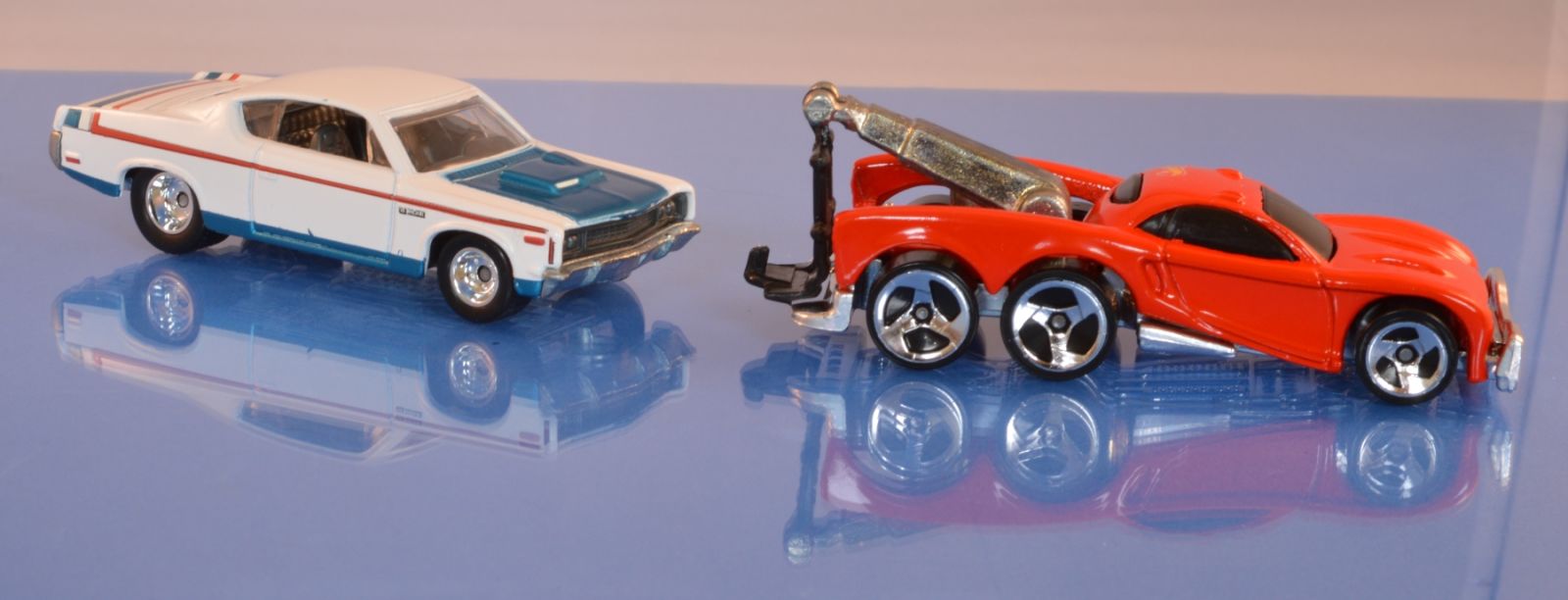R’oh-oh, looks like The Machine has broken down. At least it’s not The Mystery Machine, but it is an also rare AMC Rebel The Machine. No need for the Scooby Gang today, because Tow Jam is on the job.

Hot Wheels 1970 AMC Rebel Machine from the 2012 Legends series and Hot Wheels Tow Jam from the 1998 First Editions series.
The Machine
The most recognizable muscle car version of the AMC Rebel was named The Machine and available for the 1970 model year, following the success of the 1969 SC/Rambler. In its most patriotic factory trim The Machine was painted white and featured bold red, white, and blue reflective stripes (made by 3M) on the bodysides that wrapped over the trunk lid.
First proposed in June 1968, the car was to have been a 1969 Rebel coupe finished in black with authoritative black wheels and fat tires, without any stripes, scoops, or spoilers, but with an aggressive, street-fighting stance. The proposed model included “The Machine” decal on the rear (that made it into production), as well as a “fab gear” logo on the front fender.

However, an even earlier attempt at a Rebel-based muscle car was produced by the AMC’s engineering team: a 1967 two-door built as a development “project” car for carburetion-testing purposes, as well as with “Group 19” high-performance options and the car was re-equipped with a modified 390 cu in (6.4 L) engine with an estimated 500 hp (373 kW; 507 PS) “capable of running in the 11-second bracket.” The car was considered a legal drag racing car, according to National Hot Rod Association (NHRA) and American Hot Rod Association (AHRA) rules and regulations in effect during those years. The Machine was finished in AMC’s trademark red, white and blue color scheme, although the color breaks were not the same as on other AMC-backed or -developed race cars.
The Machine was developed from a collaboration between Hurst Performance and AMC, but unlike the compact SC/Rambler, there was no official connection between the two parties once production commenced. The standard engine in The Machine was AMC’s 390 cu in (6.4 L) V8 engine with 340 hp (254 kW; 345 PS) and 430 lb·ft (583 N·m) of torque @ 3600 rpm. It came with special heads, valve train, cam, as well as a redesigned intake and exhaust. This was the most powerful in any AMC vehicle while retaining features required for normal street operations, as well as components to assure outstanding performance characteristics without incurring high-unit cost penalties.

The Machine features a large ram-air intake hood scoop that was painted Electric Blue with a large tachometer visible to the driver integrated into a raised fairing at the rear of the scoop. This hood-mounted tach came from the same vendor as used on competing makes with only different dial faces. Early production hood scoops were fiberglass, while those installed on Machines after 1 January 1970 were injection molded and of higher quality. The heavy-duty suspension was augmented by station wagon springs in the rear (with higher load rating) giving the car a raked look. Standard were a Borg-Warner T-10 four-speed manual transmission with a Hurst floor shifter backed by either 3.54:1 or 3.91:1 rear axle gear ratios in the “Twin-Grip” differential, as well as power disc brakes, wide E60x15 Goodyear Polyglas white letter tires mounted on “Machine” mag-styled steel 15-inch (381 mm) x 7-inch (178 mm) wheels, and a black interior with bucket seats and a center armrest upholstered in red, white, and blue vinyl.
Advertisements in magazines such as Hot Rod teased that The Machine is not as fast as a 427 cu in (7.0 L) Chevrolet Corvette or a Chrysler Hemi engine, but it will beat a “Volkswagen, a slow freight train, or your old man’s Cadillac”. Numerous upgrades were standard to make each Machine a potent turnkey drag racer. In contrast to the lack of options on the SC/Rambler, Machine buyers could order numerous extras from the factory. These included substituting the manual for a center console mounted “pistol grip” automatic transmission for $188, adding cruise control cost $60, a adjustable tilting steering wheel cost $45, and even air conditioning was available for an additional $380. Furthermore, American Motors dealers sold numerous performance parts over the counter, such as an incredibly steep 5.00:1 gearing “for hardcore drag-racer types.” An optional “service kit” for $500.00 increased horsepower to well over 400 hp (298 kW; 406 PS) and lowered its quarter mile drag strip times from 14.4 with the factory Autolite carburetor to 12.72 seconds.[65]

The manufacturer’s suggested retail price (MSRP) price was $3,475. After the initial run of 1,000 units with its distinctive and easily recognizable identity, The Machine was available without the stripes in other colors with a blacked out hood. A unique paint schemes for the Machine is Frost White with a flat-black hood, with only three made. Another exclusive version came in “Big Bad Green” with only one known factory documented original car remaining. The original trim scheme became a $75 option. There were a total of 2,326 Rebel Machines built in 1970.
In 1971 the ‘Machine’ option was offered again as a package for the re-styled Rebel named Matador.